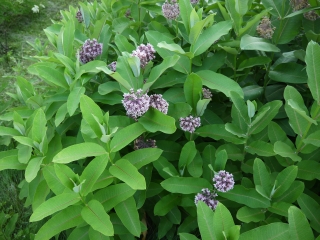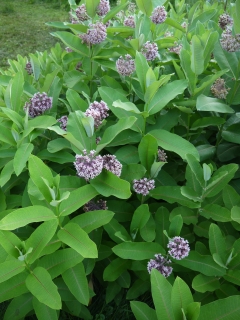home |
avr microcontroller & DIY electronics |
toolbox |
science club |
tuxtalk |
photos |
e-cards |
Online-Shop

no preservatives added blog |
computer and graphics corner |
herbal treasure chest |
splash into math |
stardust |
periodic table
milkweed (asclepias syriaca)

If you want to attract monarch butterflies to your garden plant milkweed. The leaves of the milkweed are the only food monarch caterpillars can eat.
how to grow:
It's easiest to grow milkweed from plants. But you can also grow milkweed from seeds. The seeds require cold stratification. You can put them in the earth in the fall and they will germinate in spring. It is very important that milkweed is grown in a sunny spot in your garden. It needs a lot of sun. Milkweed is a perennial that is hardy in US zones 2-8.
medicinal properties:
Milkweed is a bit toxic.
Nonetheless did the Native Americans use it.
Topically they applied the white sap on warts to remove them. They did this daily for several weeks.
They chewed on the roots to cure dysentery (a gastrointestinal disease that causes bloody diarrhea).
And they prepared an infusion of the roots and leaves to suppress coughs, treat asthma and other lung problems as well as typhus fever. It is said that an infusion of milkweed can also help with removing gallstones and kidney stones. An infusion of the roots was also used as a contraceptive.
The leaves and the sap were used by Native Americans to treat cancer and tumors.
The cooked stems were applied as poultices on rheumatic joints.
Milkweed needs to be boiled in the right way so that the toxins get out before it can be eaten.
Boiling removes the water-soluble toxins. It needs to be boiled several times and each time the water needs to be replaced.
Milkweed has several other uses, for example it is used as insulation for winter coats and for acoustic insulation.
cautions and possible side effects:
- Don't get milkweed sap in your eyes.
- Some people are already allergic when they get the sap on their skin.
- Watch out for look alikes like dogbane that are poisonous.
- Milkweed contains cardiac glycosides. Therefore it can only be eaten if it was boiled repeatedly to remove the toxins. Possible symptoms if the toxins are still there are respiratory paralysis, loss of muscle control, weakness, weak pulse and violent spasms among others. So be really careful with this herb.
- Milkweed should not be used over a long period of time.
- If you are pregnant or breastfeeding you shouldn't eat milkweed and children should also not eat it at all.
- People with heart problems or high blood pressure also shouldn't eat milkweed.
- You really need to be very careful with this herb.

further reading:
Copyright © 2004-2025 Katja Socher, tuxgraphics.org



